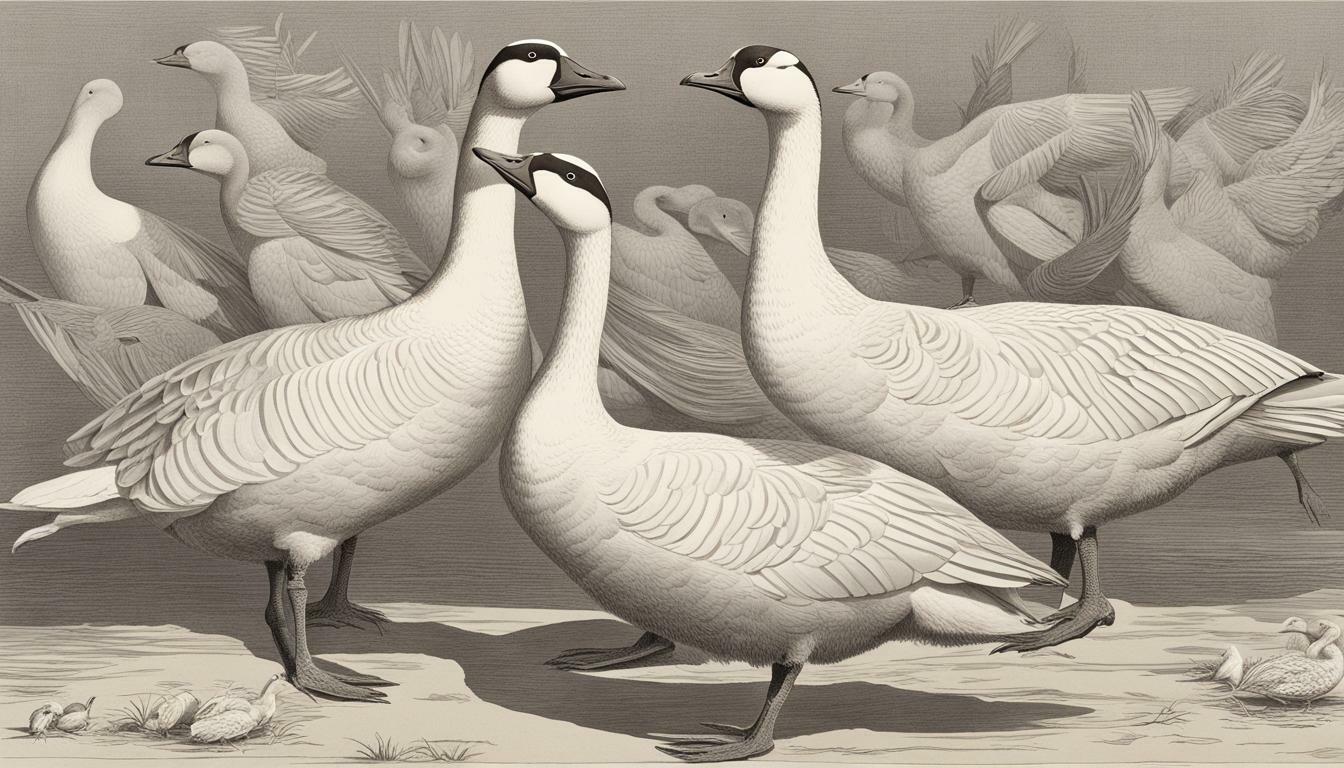Do Geese Have Ears?

Table of content:
- Ear Structure in Geese
- Do Geese Have Ear Holes?
- Can Geese Hear Underwater?
- Do Baby Geese Have Ears When They Hatch?
- Do Geese Use Their Ears to Communicate?
- What’s Inside a Goose’s Ear?
- How Good is a Goose’s Sense of Hearing?
- Do Geese Have Ears That Stick Out?
- Do Geese Have Better Hearing Than Humans?
- Do Geese Close Their Ears When Swimming?
- How Do Geese Hear Danger Coming?
- Final Thoughts
Geese are common waterfowl birds found throughout North America. With their distinctive honking calls and V-shaped flying formations, geese are a familiar sight to many. But do these unique birds have ears like humans and other animals? The answer is yes – geese do have ears, although they are not easily visible.
Ear Structure in Geese
Geese have an auditory system and ears adapted for hearing both in the air and underwater. A goose’s ears consist of ear canals and holes covered by specialized feathers. The ears lack external pinnae or outer ears, that funnel sound into the ear canal in mammals. Instead, the ear opening is a simple round hole on each side of the head, right below the eyes.
The goose’s ear canal leads to the eardrum and then the middle ear, containing small bones that transmit vibrations to the inner ear. The inner ear contains the cochlea, which converts sound waves into nerve signals that travel to the brain.
While less obvious, this ear structure allows geese to hear a variety of important sounds. Geese can detect prey, predators, calls from other geese, and changes in the environment using their specialized hearing apparatus.
Do Geese Have Ear Holes?
Yes, geese do have small openings on each side of their head that serve as ear holes. The holes are covered in specialized short, stiff feathers that protect the sensitive inner ear from water, debris, and damage. The feathers around a goose’s ear holes are called auriculars.
Goose ears lack larger, cupped pinnae to collect and funnel sound into the ear canal. But the small holes surrounded by auricular feathers work effectively as goose ears. The stiff feathers help deflect water and particles away from the ear canal openings. This allows geese to hear while swimming and diving underwater.
Can Geese Hear Underwater?
While not as adept as fully aquatic birds, geese are able to hear reasonably well when submerged. The auricular feathers and structure of a goose’s inner ear help protect hearing when underwater.
When diving, geese have the ability to close their ear openings by tensing special muscles around the ear canal. This helps prevent water from entering the sensitive middle and inner ear structures. A waterproof preen oil that geese spread over their feathers provides additional insulation and water resistance.
These adaptations allow geese to hear muffled, low-frequency sounds while swimming or feeding with their head underwater. However, their underwater hearing is likely more limited than in the air. To communicate and listen for predators, geese typically keep their heads above water as much as possible.
Do Baby Geese Have Ears When They Hatch?
Yes, goslings (baby geese) are born with ears and the ability to hear sounds right after hatching from the egg. The specialized feathers over the ear holes begin growing a few weeks after hatching. However, the underlying ear structure is present and functional at birth.
A gosling’s hearing is critical for becoming aware of its parents and siblings soon after hatching. Gosling ears can detect the parental calls that guide them to food sources and safe locations. Hearing the contact calls of other goslings and adults is vital for surviving as a vulnerable young goose.
Within hours after hatching, goslings respond to the sound of their parents’ voices. Newly hatched goslings can also distinguish the unique tones of different adult geese that signal whether they are related or strange geese.
Do Geese Use Their Ears to Communicate?
Geese rely heavily on hearing and vocalizations to communicate within flocks. Adult geese produce a range of vocal sounds that have different meanings to other geese. From loud warning calls to subtle murmurs, geese use complex language patterns to convey information.
Hearing the various goose calls and responding appropriately is essential for flock cohesion and safety. For example, specific calls alert others to the presence of food or danger. And goslings recognize the unique voices of their parents shortly after hatching.
Migrating geese call frequently to maintain contact with flock members as they travel together over long distances. So hearing and responding to other geese enables many key behaviors for survival and reproduction in geese.
What’s Inside a Goose’s Ear?
The ear of a goose contains the same basic structures found in other bird species:
- Ear canal – The tube running from the external ear opening to the eardrum. The canal is lined with fine hairs and wax that protect the inner ear.
- Eardrum – Also called the tympanic membrane, this thin layer vibrates in response to sound waves.
- Middle ear – Contains three tiny bones called ossicles that transmit eardrum vibrations to the inner ear.
- Inner ear – Consists of two fluid-filled chambers, the cochlea for hearing and vestibule for balance.
- Cochlea – Spiral structure lined with hair cells that detect sound vibrations and convert them to nerve impulses sent to the brain.
- Auditory nerve – Carries messages about sound from the inner ear to the brain.
This avian ear anatomy allows geese to convert air vibrations into meaningful sounds used for communication, navigation, and survival.
How Good is a Goose’s Sense of Hearing?
Geese have relatively sensitive hearing covering a wide range of sound frequencies. They can detect sounds between about 55 Hz to 15 kHz, similar to the human hearing range. Geese are especially adept at discerning distinct voices and language-like sounds of other geese.
In some studies, geese have demonstrated the ability to distinguish between individual geese by listening to their calls. This allows them to differentiate dangerous unknown geese from familiar family and flock members. Researchers believe geese can identify specific voices just like humans recognize familiar individuals by their voices.
Geese can also locate sounds well to gain information about their environment and the location of other birds. Overall, geese have hearing abilities well adapted to their needs as highly social and vocal waterfowl.
Do Geese Have Ears That Stick Out?
Unlike many mammals, geese do not have prominent outer ears or ear flaps. The openings to a goose’s ears lack raised, visible pinnae that funnel sound waves into the ear canal. Instead, geese have a simple ear hole on each side of the head surrounded by specialized small feathers.
These relatively indistinct ears are well suited for a bird that spends time both in the water and air. Streamlined ear openings reduce water resistance when swimming and prevent debris from entering the ear canal when flying. The feather covering also protects the ears from damage.
While less conspicuous, goose ears are still effective at collecting sound waves. The feathers surrounding the ear openings help reflect and focus sound into the canal. So while less prominent, the goose’s ear structure suits its amphibious lifestyle.
Do Geese Have Better Hearing Than Humans?
Overall, geese and humans have similarly sensitive hearing abilities. Both detect sounds within a wide range of frequencies needed for communication and environmental awareness.
However, geese may have some advantages over human hearing:
- Geese can localize sound direction more precisely, useful for flock communication.
- They hear better underwater, aided by ear adaptations for diving.
- Geese distinguish individual voices and language patterns with more sophistication.
- Their hearing remains sharp even at older ages.
On the other hand, humans exceed geese in detecting subtle differences in sound pitch and quality. Human ears also perceive some high-frequency sounds above a goose’s hearing range.
While geese have very capable hearing, humans have some strengths due to structural differences in our ears. Overall, the auditory abilities of geese and humans are quite comparable in most respects.
Do Geese Close Their Ears When Swimming?
Geese can actively close off their ear canals when submerged in water. Specialized muscles surrounding the ear opening constrict to pinch shut the ear canal. This prevents water from entering the middle and inner ear compartments.
Ear closing occurs reflexively in aquatic birds like geese when they dive or swim underwater. In conjunction with waterproofing ear feathers, this protects the ears from damage and dampened hearing.
When they surface, geese can open their ears again rapidly. The quick ear-closing response helps geese hear well when they need to while swimming or feeding underwater temporarily.
How Do Geese Hear Danger Coming?
Geese rely heavily on their hearing to detect potential danger while feeding or resting. Their ears are constantly “on alert” for any unusual sounds signaling a threat in the surroundings.
If geese hear a disturbance, they become highly vocal, emitting warning calls to other geese. Adults will run towards their goslings while loudly hissing at the source of danger. Geese hearing an alarm call prepare to fly away if the threat gets too close.
Caution calls notify geese to be vigilant, while loud distress calls prompt them to flee the area right away. Flock members quickly become aware of hazards by listening for specific warning vocalizations. Geese survive by hearing danger coming well in advance thanks to their keen ears.
Final Thoughts
While small and concealed by feathers, geese do indeed have specially adapted ears to hear both in air and water. Their hearing structures allow geese to communicate with distinct calls, locate sounds, and detect threats in their environment. Geese rely on their sensitive ears and vocalizations to interact with flock mates and offspring for survival. So next time you see geese honking loudly, remember that they are having a conversation made possible by their well-developed ears.
Welcome. I’m Adreena Shanum, the proud owner of this website, and I am incredibly passionate about animals, especially poultry. I founded adreenapets.com as a labor of love, stemming from my desire to share my knowledge and experiences with poultry enthusiasts worldwide.




